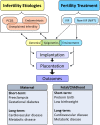Genetics and Epigenetics of Infertility and Treatments on Outcomes
- PMID: 30561694
- PMCID: PMC6463256
- DOI: 10.1210/jc.2018-01869
Genetics and Epigenetics of Infertility and Treatments on Outcomes
Abstract
Context: Infertility affects 10% of the reproductive-age population. Even the most successful treatments such as assisted reproductive technologies still result in failed implantation. In addition, adverse pregnancy outcomes associated with infertility have been attributed to these fertility treatments owing to the presumed epigenetic modifications of in vitro fertilization and in vitro embryo development. However, the diagnosis of infertility has been associated with adverse outcomes, and the etiologies leading to infertility have been associated with adverse pregnancy and long-term outcomes.
Evidence acquisition: We have comprehensively summarized the data available through observational, experimental, cohort, and randomized studies to better define the effect of the underlying infertility diagnosis vs the epigenetics of infertility treatments on treatment success and overall outcomes.
Evidence synthesis: Most female infertility results from polycystic ovary syndrome, endometriosis, and unexplained infertility, with some cases resulting from a polycystic ovary syndrome phenotype or underlying endometriosis. In addition to failed implantation, defective implantation can lead to problems with placentation that leads to adverse pregnancy outcomes, affecting both mother and fetus.
Conclusion: Current research, although limited, has suggested that genetics and epigenetics of infertility diagnosis affects disease and overall outcomes. In addition, other fertility treatments, which also lead to adverse outcomes, are aiding in the identification of factors, including the supraphysiologic hormonal environment, that might affect the overall success and healthy outcomes for mother and child. Further studies, including genome-wide association studies, epigenomics studies, and experimental studies, are needed to better identify the factors leading to these outcomes.
Copyright © 2019 Endocrine Society.
Figures
References
-
- Faddy MJ, Gosden MD, Gosden RG. A demographic projection of the contribution of assisted reproductive technologies to world population growth. Reprod Biomed Online. 2018;36(4):455–458. - PubMed
-
- Schieve LA, Meikle SF, Ferre C, Peterson HB, Jeng G, Wilcox LS. Low and very low birth weight in infants conceived with use of assisted reproductive technology. N Engl J Med. 2002;346(10):731–737. - PubMed
-
- Jackson RA, Gibson KA, Wu YW, Croughan MS. Perinatal outcomes in singletons following in vitro fertilization: a meta-analysis. Obstet Gynecol. 2004;103(3):551–563. - PubMed
-
- Hansen M, Kurinczuk JJ, Bower C, Webb S. The risk of major birth defects after intracytoplasmic sperm injection and in vitro fertilization. N Engl J Med. 2002;346(10):725–730. - PubMed
Publication types
MeSH terms
Grants and funding
LinkOut - more resources
Full Text Sources
Medical


